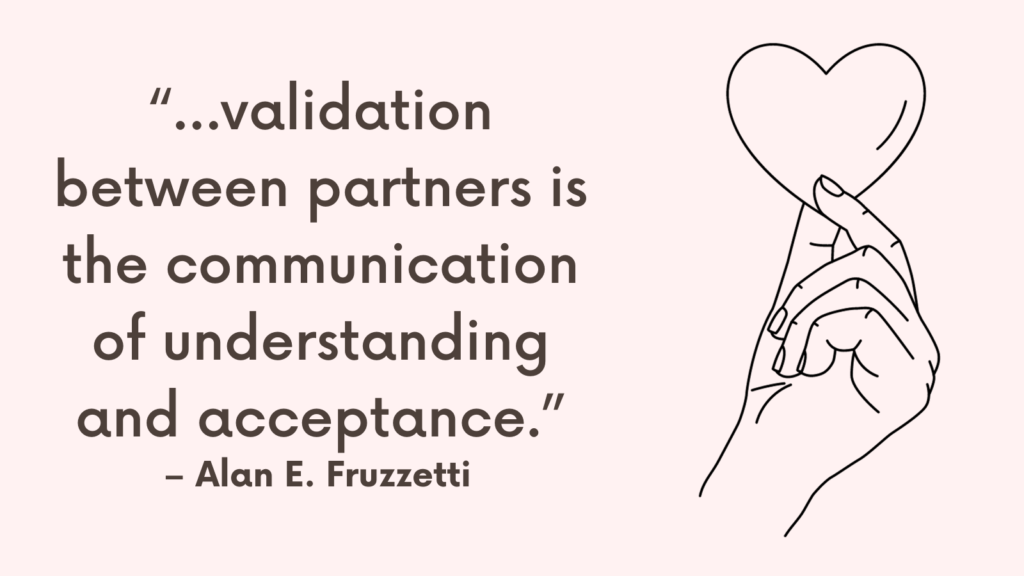In this post, you’re going to learn the difference between affirming vs validating
Affirm vs Validate
Affirmation and validation are two crucial that play a significant role in our interpersonal relationships.
While these terms are often used interchangeably, they have distinct meanings and implications.
Let’s start by understanding affirmation.
1. Affirmation
Affirmation refers to the act of acknowledging and recognizing the worth or value of a person’s thoughts, feelings, or actions.
It involves expressing positive support, encouragement, and appreciation for someone’s qualities or achievements.
When we affirm someone, we focus on highlighting their strengths and conveying belief in their abilities.
This can enhance their self-esteem, self-worth, and overall well-being.
Affirmation is a powerful tool in building and maintaining healthy relationships.
By affirming others, we create an environment that promotes positivity, growth, and confidence.
It sends a message that their contributions are valued and appreciated, which boosts their motivation and encourages them to continue their efforts.
Affirmation also fosters a sense of psychological safety, making individuals more willing to take risks and explore new possibilities.
Examples:
- “I admire your strength and resilience in facing challenges. You inspire me every day.”
- “You are an amazing listener. Thank you for always being there for me and understanding my thoughts and feelings.”
- “I appreciate your effort and hard work to make our relationship thrive. Your dedication means the world to me.”
- “Your kindness and thoughtfulness never cease to amaze me. I’m lucky to have such a caring partner.”
- “You make me feel loved and cherished. I treasure the bond we share.”
- “I believe in you and your dreams. Your ambition and determination inspire me to reach for my own goals.”
- “Your sense of humor brings so much light into our relationship. I love laughing and having fun with you.”
- “You are beautiful both inside and out. Your presence brightens up any room.”
Related: How To Validate Someone’s Feelings Without Agreeing? (+Examples of Validating Statements)
2. Validation
In contrast, validation involves acknowledging and accepting someone’s emotions, experiences, or perspectives as valid, irrespective of whether we agree with them.
It is about empathizing with their feelings and showing understanding and respect for their point of view.
Validating someone does not imply agreement but rather acknowledges their right to have their own emotions and experiences.
This validation can create a sense of psychological safety and enhance trust and connection in relationships.
Validation is particularly important when it comes to emotions.
Many individuals seek validation for their feelings, wanting to be heard and understood rather than judged or dismissed.
When we validate someone’s emotions, we let them know that we recognize and accept their feelings as legitimate, regardless of our own opinions.
This demonstrates empathy, compassion, and respect, which can strengthen relationships and foster emotional well-being.
Examples:
- “I hear you and understand how you’re feeling. Your perspective is important to me.”
- “It makes sense that you would feel that way given the circumstances. Your emotions are valid.”
- “You’ve been through a lot, and it’s okay to feel overwhelmed. I’m here to support you.”
- “I understand why that situation would have upset you. Your reaction is understandable.”
While affirmation focuses on positive attributes and achievements, validation centers on understanding and accepting the emotions and experiences of others.
Both processes are vital for building strong bonds, fostering open communication, and promoting emotional well-being.
However, it is important to note that they serve different purposes and may be appropriate in different situations.
Related: How To Respond To Invalidation? Top 7 Things You Can Do
FREE Validating Statements PDF
How to Incorporate Affirmation and Validation In Relationships?
1. Pay attention
Actively listen to what the other person is saying and show genuine interest in their perspective.
This demonstrates that you value their thoughts and emotions.
Maintain eye contact, use body language that conveys attentiveness, and refrain from distractions or interruptions.
This creates a space where affirmation and validation can occur naturally.
2. Use affirming language
Offer words of encouragement and support that highlight the person’s strengths, accomplishments, or positive qualities.
For example, you might say, “I appreciate your hard work on this project; you did an excellent job!” or “Your creativity and problem-solving skills really shine in this situation.”
Provide specific examples of what you admire or value about the person.
This kind of affirmation can boost their confidence and self-belief.
3. Reflect on emotions
Validate the other person’s emotions by acknowledging and naming what they might be feeling.
This shows empathy and understanding. For instance, you might say, “It sounds like you’re feeling frustrated and overwhelmed by the situation.”
Reflecting on emotions allows the person to feel heard and understood, creating a sense of validation that can alleviate emotional distress.
Related: Best 8 Mindfulness Exercises For Adults That Will Help You Regulate Your Emotions
4. Avoid judgment
One of the fundamental aspects of validation is refraining from judgment.
It is essential to create a safe space where individuals can express themselves without fear of criticism or rejection.
Avoid belittling or dismissing their experiences or emotions, even if you hold a different perspective.
Instead, focus on validating their right to feel the way they do.
Related: Best 10 Books On Validation
5. Be non-defensive
In situations where discussions or conflicts arise, strive to remain open-minded and avoid becoming defensive.
Validating the other person’s concerns, even if you disagree with them, can facilitate constructive dialogue and resolution.
Demonstrate active listening skills by paraphrasing what they’ve said and reflecting back their feelings.
This contributes to a greater understanding of their perspective and helps build trust.
Related: 4 Essential Keys To Effective Communication

Conclusion
Affirmation and validation are powerful tools in fostering healthy relationships and promoting emotional well-being.
Affirmation involves recognizing and appreciating someone’s qualities and achievements, boosting their self-esteem and motivation.
Validation, on the other hand, entails empathizing with and accepting someone’s emotions and experiences, enhancing trust and connection.
Incorporating affirmation and validation into our interactions requires active listening, empathy, and genuine care for the other person.
By paying attention, using affirming language, reflecting on emotions, avoiding judgment, and being non-defensive, we can create an environment that supports personal growth, strengthens relationships, and nurtures emotional well-being.



